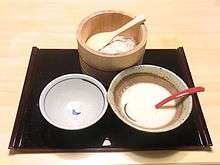Dioscorea japonica
Dioscorea japonica, known as East Asian mountain yam,[1] yamaimo, or Japanese mountain yam, is a type of yam (Dioscorea) native to Japan (including Ryukyu and Bonin Islands), Korea, China, Taiwan, and Assam.[2][3]
| Dioscorea japonica | |
|---|---|
| Scientific classification | |
| Kingdom: | |
| (unranked): | |
| (unranked): | |
| Order: | |
| Family: | |
| Genus: | |
| Species: | D. japonica |
| Binomial name | |
| Dioscorea japonica Thunb. 1784 | |
Dioscorea japonica is used for food. Jinenjo, also called the wild yam, is a related variety of Japanese yam that is used as an ingredient in soba noodles.
Names
In Japanese, it is known as yamaimo (山芋) "mountain yam".[4]
jinenjo (自然薯) "wild yam" is another kind of Dioscorea japonica, which is native to fields and mountains in Japan.
In Chinese it is known as Yěshān yào (野山药)[5] which translates to English as wild mountain medicine. Another name is rìběnshǔyù (literally Japanese yam; 日本薯蓣[3])
In Korean it is known as cham ma 참마, as well as dang ma 당마.
Chemistry
Dioscorea japonica contains the antimutagenic compounds eudesmol and paeonol.[6]
Varieties
Several formal botanical varieties have been proposed. Four are accepted:[2][3]
- Dioscorea japonica var. japonica - Japan, Korea, Ryukyu, Bonin, Anhui, Fujian, Guangdong, Guangxi, Guizhou, Hubei, Hunan, Jiangsu, Jiangxi, Sichuan, Taiwan, Zhejiang
- Dioscorea japonica var. nagarum Prain & Burkill - Assam
- Dioscorea japonica var. oldhamii R.Knuth - Guangdong, Guangxi, Taiwan
- Dioscorea japonica var. pilifera C.T.Ting & M.C.Chang - Anhui, Fujian, Guangxi, Guizhou, Hubei, Hunan, Jiangsu, Jiangxi, Zhejiang
Uses
In Japanese cuisine, both the Japanese yam and the introduced Chinese yam are used interchangeably in dishes and recipes.[7]
References
- English Names for Korean Native Plants (PDF). Pocheon: Korea National Arboretum. 2015. p. 442. ISBN 978-89-97450-98-5. Retrieved 4 January 2017 – via Korea Forest Service.
- Kew World Checklist of Selected Plant Families
- "Dioscorea japonica in Flora of China @ efloras.org". Missouri Botanical Garden, St. Louis, MO & Harvard University Herbaria, Cambridge, MA. Retrieved 21 January 2012.
- Ohwi, Jisaburo (1965). Meyer, Frederick G.; Walker, Egbert H. (eds.). Flora of Japan. Washington, DC: Smithsonian Institution. p. 314. OCLC 742327504. Retrieved 21 January 2012.
- "野山药".
- Antimutagenic Activity of (+)-β-Eudesmol and Paeonol from Dioscorea japonica. Mitsuo Miyazawa, Hideo Shimamura, Sei-ichi Nakamura and Hiromu Kameoka, J. Agric. Food Chem., 1996, 44 (7), pages 1647–1650, doi:10.1021/jf950792u
- Itoh, Makiko (2015-07-15). "'Yamaimo': Japan's slimy mountain yam". The Japan Times. Retrieved 2019-06-07.
